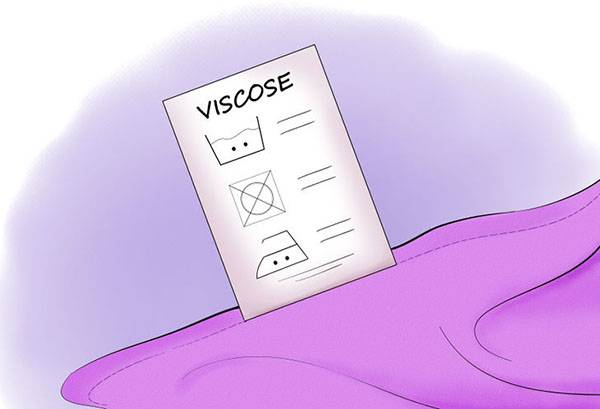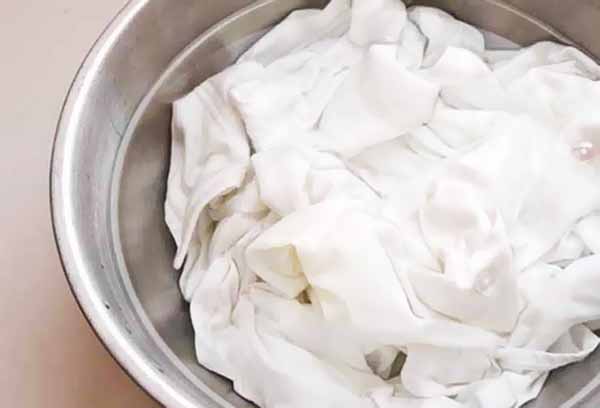How to properly wash viscose products so that it does not shrink?
If you recently acquired a delicate faux silk dress or a new bright blouse, you need to know how to wash viscose. Just one wrong decision can ruin something you like. Viscose, or artificial silk, as it is popularly called, has been popular for more than a century. The fabric has a number of advantages over other synthetic materials, which is why it is loved by many clothing manufacturers.
- It absorbs moisture perfectly.
- Easy to paint.
- It allows air to pass through, allowing the body to “breathe”.
The basis of the material is wood cellulose. Despite the second name, the fabric does not always resemble natural silk. Through experimentation, manufacturers have learned to make fabric with a structure similar to wool, cotton and linen. Since viscose is a luxurious, but finicky “lady”, it needs proper care. After one wash in the drum of a washing machine in an inappropriate mode, a viscose dress will turn into old rags.

Preparing for washing
To avoid ruining a viscose blouse or dress once and for all, examine the tag on the back of the item. Most often, the manufacturer provides precise recommendations for washing, drying and ironing. By sticking to them, you won't have to say goodbye to things ahead of time.
If the tag is cut off and you have not previously machine washed viscose items, follow the rules.
- Sort all wardrobe items by color (viscose items are often dyed in bright colors, which may fade when washed).
- Check if the pockets are empty (a forgotten metal element can cause rust on the fabric and damage the washing machine).
- Fasten buttons, zippers, rivets.
- Turn everything inside out to help extend their durability.
Soak
Soaking is only required in cases of heavy soiling and is not a necessary washing step. Perhaps a passing car splashed you with dirty water, or a child decided to play in the sandbox in a smart viscose suit. To ensure that the dirt is washed off, the item must be soaked in soapy water for at least half an hour.
Fill a basin with cold water (maximum 30 degrees). Add a small amount of hand washing powder. More suitable are special liquid products designed for washing wool or delicate fabrics. If you don't have any of the above products in your home, make a strong solution of laundry soap. The item needs to be soaked for half an hour, then easily wrung out and placed in the drum of the washing machine.
Advice
Do not rub the contaminated area with your hands or brushes, as this will damage the fabric structure.
Hand wash
The question of how to wash viscose is especially acute, because this fabric shrinks after improper washing. If you are not limited by time, wash the product by hand. In this case, you need to soak the item and then carefully wash it with light movements. Do not rub it or squeeze it with force. Monitor the water temperature - it should not exceed 30 degrees.
Machine washable
Special modes, which are present in all modern models of washing machines, allow you to wash even delicate items. Things made of viscose are no exception. Set your machine to the “Hand Wash” program or the “Delicate” mode. The water temperature in such modes usually does not exceed 30 degrees. By setting the temperature to a higher temperature, don’t be surprised that your favorite item shrinks.
Make sure the spin function is turned off. Typically, washing in a delicate cycle involves automatically turning off the spin cycle. To protect clothes from mechanical damage in the machine, you need to use a special bag for washing machines.
If, after washing in compliance with all the rules, the item still shrinks, it means:
- the purchased product turned out to be of poor quality;
- the item is made of viscose mixed with wool, acrylic or polyester.
Drying and ironing
To preserve the “presentation” of a viscose product, forget about machine drying. Do not hang items on radiators or warm water coils. The ideal option for drying viscose is a horizontal surface. Lay down a thick terry towel, place a wet, slightly wrung-out product on top and smooth out any noticeable bruises with your hands. To remove excess moisture, place another towel on top and press it against the item with your palms.
Advice
Avoid direct sunlight when drying.
Viscose can only be ironed from the reverse side. This will prevent you from ruining the appearance. Set your iron to the lowest temperature setting. It is advisable to use gauze when ironing. If the fabric remains wrinkled, spray it with water. Do not use the steam function.
If you follow all the rules, the process of washing and ironing delicate items will become a simple task for you.Treat your clothes with care!




What does it mean “Fabric has a number of advantages over other synthetic materials, which is why it is loved by many clothing manufacturers.”? What does synthetics have to do with it if it is an artificial fabric?
For reference: natural fibers created by nature of plant or animal origin... cotton, wool.
Artificial fibers created by chemical processing of organic matter from wood, milk, etc. (viscose acetate) through spinnerets.
Synthetics are made from naphtha, etc., using chemical synthesis.